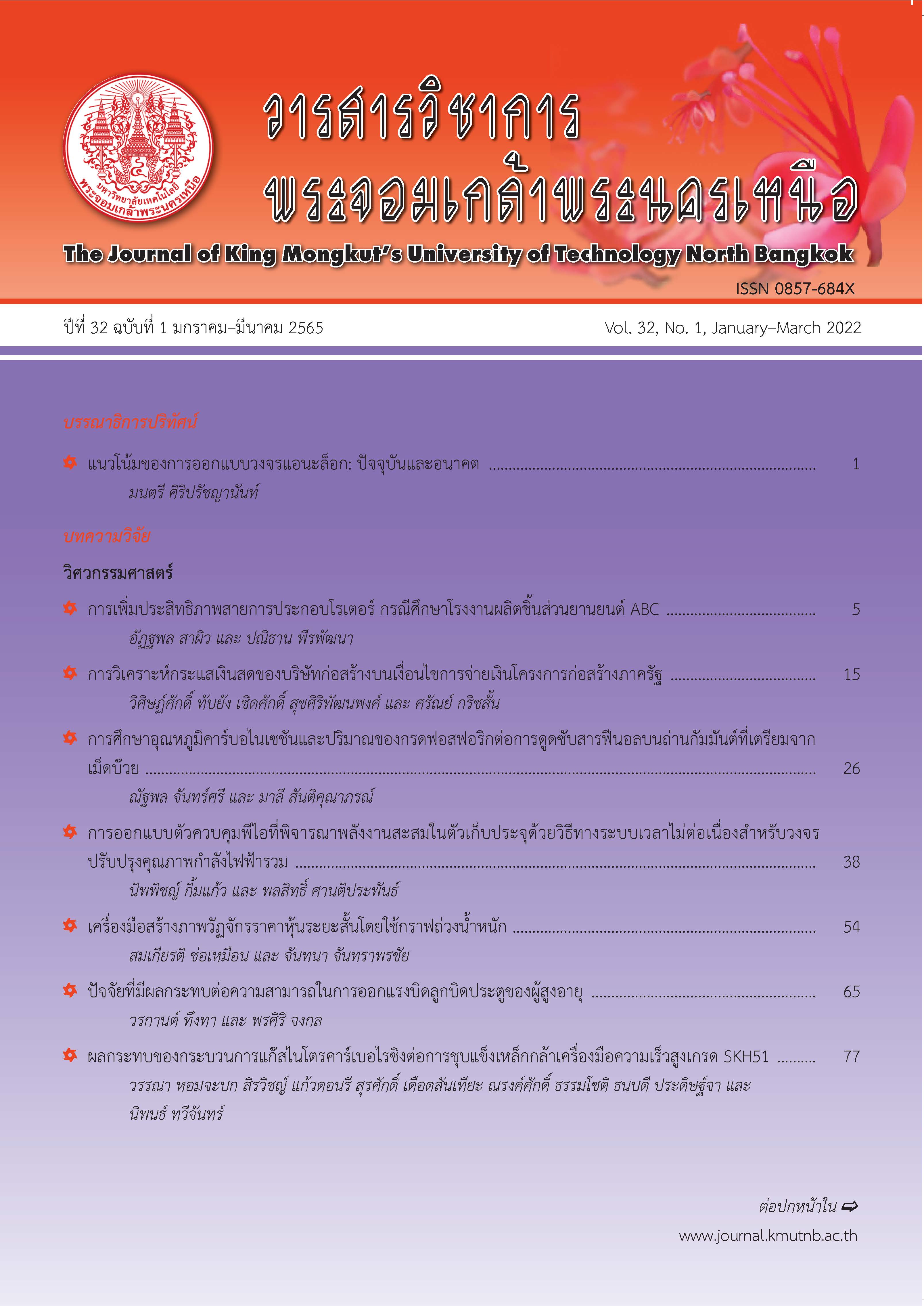การพัฒนาความคงรูปของไฮโดรเจลจากเส้นใยปาล์มด้วยยางธรรมชาติ
Main Article Content
บทคัดย่อ
ปาล์มเป็นพืชชนิดหนึ่งที่มีปริมาณเซลลูโลสสูงสามารถนำไปใช้ทำเป็นไฮโดรเจลได้ แต่ยังมีสมบัติการคงรูปที่ไม่ดี งานวิจัยนี้จึงมีวัตถุประสงค์เพื่อเพิ่มสมบัติความคงรูปของไฮโดรเจลจากเส้นใยปาล์มด้วยยางธรรมชาติ โดยการเตรียมไฮโดรเจลผสม สามารถเตรียมได้ที่อัตราส่วนระหว่างสารละลายเซลลูโลสจากเส้นใยปาล์ม 90–95% โดยปริมาตรต่อสารละลายยางธรรมชาติ 5–10% โดยปริมาตร ด้วยการกวนสารละลายผสมให้เข้าเป็นเนื้อเดียวกัน หลังจากนั้นนำสารละลายผสมไปทำให้เจลคงรูปด้วยวิธีการเปลี่ยนเฟสแบบเปียก ซึ่งไฮโดรเจลผสมนี้มีความคงรูป และความแข็งแรงที่ดีกว่าไฮโดรเจลที่เตรียมได้จากเส้นใยปาล์มเพียงอย่างเดียว สังเกตได้จากกล้องจุลทรรศน์อิเล็กตรอนแบบส่องกราด จะเห็นการเชื่อมต่อของโครงร่างตาข่ายในไฮโดรเจล โดยอนุภาคของยางธรรมชาติเข้าไปเติมเต็มที่ช่องว่างระหว่างโครงร่างตาข่ายทำให้เกิดการเชื่อมผสานของช่องว่าง ซึ่งยางธรรมชาติจะทำหน้าที่เป็นวัสดุเสริมแรง นอกจากนี้การทดสอบเปอร์เซ็นต์การดูดซับน้ำของไฮโดรเจลผสมที่เตรียมได้พบว่า ยังมีอัตราการดูดซับน้ำที่สูง ถึงแม้ว่าจะน้อยกว่าไฮโดรเจลที่เตรียมได้จากเส้นใยปาล์มเพียงอย่างเดียว แต่ก็ยังสามารถนำไปใช้งานเป็นวัสดุดูดซับน้ำที่ดีได้
Article Details
บทความที่ลงตีพิมพ์เป็นข้อคิดเห็นของผู้เขียนเท่านั้น
ผู้เขียนจะต้องเป็นผู้รับผิดชอบต่อผลทางกฎหมายใดๆ ที่อาจเกิดขึ้นจากบทความนั้น
เอกสารอ้างอิง
[2] D. Pasqui, P. Torricelli, M. De Cagna, M. Fini, and R. Barbucci, “Carboxymethyl cellulosehydroxyapatite hybrid hydrogel as a composite material for bone tissue engineering applications,” Journal of Biomedical Materials Research Part A, vol. 102, no. 5, pp. 1568–1579, 2014.
[3] S. Park, S. H. Kim, J. H. Kim, H. Yu, H. J. Kim, Y.-H. Yang, H. Kim, Y. H. Kim, S. H. Ha, and S. H. Lee, “Application of cellulose/lignin hydrogel beads as novel supports for immobilizing lipase,” Journal of Molecular Catalysis B-Enzymatic, vol. 119, pp. 33–39, 2015.
[4] D. F. Li, Y. X. Ye, D. R. Li, X. Y. Li, and C. D. Mu, “Biological properties of dialdehyde carboxymethyl cellulose crosslinked gelatin-PEG composite hydrogel fibers for wound dressings,” Carbohydrate Polymers, vol. 137, pp. 508–514, 2016.
[5] N. Mohammed, N. Grishkewich, R. Berry, and K. Tam, “Cellulose nanocrystal-alginate hydrogel beads as novel adsorbents for organic dyes in aqueous solutions,” Cellulose, vol. 22, pp. 3725–3738, 2015.
[6] M. M. Ibrahim, M. Abd-Eladl, and N. H. Abou-Baker, “Lignocellulosic biomass for the preparation of cellulose-based hydrogel and its use for optimizing water resources in agriculture,” Journal of Applied Polymer Science, vol. 132, no. 42, pp. 1–12, 2015.
[7] D. W. Davidson, M. S. Verma, and F. X. Gu, “Controlled root targeted delivery of fertilizer using an ionically crosslinked carboxymethyl cellulose hydrogel matrix,” Springerplus, vol. 2, pp. 1–9, 2013.
[8] A. Bortolin, F. A. Aouada, L. H. C. Mattoso, and C. Ribeiro, “Nanocomposite PAAm/methyl cellulose/montmorillonite hydrogel: Evidence of synergistic effects for the slow release of fertilizers,” Journal of Agricultural and Food Chemistry, vol. 61, no. 31, pp. 7431–7439, 2013,
[9] C. Vudjung, U. Chaisuwan, U. Pangan, N. Chaipugdee, S. Boonyod, O. Santawitee, and S. Saengsuwan, “Effect of natural rubber contents on biodegradation and water absorption of interpenetrating polymer network (IPN) hydrogel from natural rubber and cassava starch,” Energy Procedia, vol. 56, pp. 255–263, 2014.
[10] C. Spagnol, F. H. A. Rodrigues, A. G. B. Pereira, A. R. Fajardo, A. F. Rubira, and E. C. Muniz, “Superabsorbent hydrogel composite made of cellulose nanofibrils and chitosan-graft-poly (acrylic acid),” Carbohydrate Polymers, vol. 87, no. 3, pp. 2038–2045, 2012.
[11] A. Sannino, M. Madaghiele, M. G. Lionetto, T. Schettino, and A. Maffezzoli, “A cellulosebased hydrogel as a potential bulking agent for hypocaloric diets: An in vitro biocompatibility study on rat intestine,” Journal of Applied Polymer Science, vol. 102, no. 2, pp. 1524–1530, 2006.
[12] E. Pinho, M. Henriques, and G. Soares, “Cyclodextrin/cellulose hydrogel with gallic acid to prevent wound infection,” Cellulose, vol. 21, pp. 4519–4530, 2014.
[13] H. Dong, J. F. Snyder, D. T. Tran, and J. L. Leadore, “Hydrogel, aerogel and film of cellulose nanofibrils functionalized with silver nanoparticles,” Carbohydrate Polymers, vol. 95, no. 2, pp. 760–767, 2013.
[14] A. Boonmahithisud, L. Nakajima, K. D. Nguyen, and T. Kobayashi, “Composite effect of silica nanoparticle on the mechanical properties of cellulose-based hydrogels derived from cottonseed hulls,” Journal of Applied Polymer Science, vol. 134, no. 10, pp. 1–12, 2017.
[15] K. L. Tovar-Carrillo, M. Tagaya, and T. Kobayashi, “Bamboo fibers elaborating cellulose hydrogel films for medical applications,” Journal of Materials Science and Chemical Engineering, vol. 1, no. 7, pp. 7–12, 2013.
[16] K. Nakasone, S. Ikematsu, and T. Kobayashi, “Biocompatibility evaluation of cellulose hydrogel film regenerated from sugar cane bagasse waste and its in vivo behavior in mice,” Industrial & Engineering Chemistry Research, vol. 55, no. 1, pp. 30–37, 2015.
[17] N. Srirachya, K. Boonkerd, L. Nakajima, and T. Kobayashi, “Bio-composite hydrogels of cellulose and vulcanized natural rubber with nanointerconnected layers for reinforced water-retaining materials,” Polymer Bulletin, vol. 75, pp. 5493–5512, 2018.
[18] N. Srirachya, K. Boonkerd, and T. Kobayashi, “Effective elongation properties of cellulosenatural rubber composite hydrogels having interconnected domain,” Journal of Elastomers & Plastics, vol. 52, no. 4, pp. 337–355, 2019.
[19] S. Gan, S. Zakaria, C. Chia, and F. Padzil, “Effect of hydrothermal pretreatment on solubility and formation of kenaf cellulose membrane and hydrogel,” Carbohydrate Polymers, vol. 115, pp. 62–68, 2015.
[20] N. Srirachya and A. Nido, “The green preparation of cellulose fibrils from oil palm leaf stalk fibers for hydrogel applications,” Key Engineering Materials, vol. 841, pp. 103–107, 2020.
[21] K. Tovar-Carrillo, K. Nakasone, S. Sugita, M. Tagaya, and T. Kobayashi, “Effects of sodium hypochlorite on agave tequilana weber bagasse fibers used to elaborate cyto and biocompatible hydrogel films,” Journal of Materials Science and Chemical Engineering, vol. 42, pp. 808–815, 2014.
[22] H. Jiang, K. Tovar-Carrillo, and T. Kobayashi, “Ultrasound stimulated release of mimosa medicine from cellulose hydrogel matrix,” Ultrasonics Sonochemistry, vol. 32, pp. 398–406, 2016.
[23] K. Li, S. Noguchi, and T. Kobayashi, “Ultrasoundresponsive behavior of gelatinous ionic liquid/poly (vinyl alcohol) composites,” Industrial & Engineering Chemistry Research, vol. 55, pp. 9915–9924, 2016.

